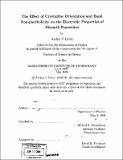The effect of crystalline orientation and band non-parabolicity on the electronic properties of bismuth nanowires
Author(s)
Levin, Andrei J
DownloadFull printable version (3.886Mb)
Other Contributors
Massachusetts Institute of Technology. Dept. of Physics.
Advisor
Mildred S. Dresselhaus.
Terms of use
Metadata
Show full item recordAbstract
Due to the unique electronic properties of bismuth, bismuth nanowires provide an attractive low-dimensional system for studying quantum confinement effects, and have generated much interest in both optical and thermoelectric applications. Two especially interesting features of bismuth nanowires are the non-parabolic nature of the electronic energy bands near the Fermi level and the large anisotropy of the carrier pockets. As a result of these features, the electronic properties of bismuth nanowires depend strongly on both crystalline orientation and nanowire diameter. In order to study the effect of crystalline orientation, we first derive a simple method to transform from hexagonal to Cartesian coordinates in the bismuth lattice. We then investigate an important indirect electronic transition in bismuth nanowires, and we use the Lax two-band model to develop a theoretical model for studying the diameter dependence of the energy of this transition for nanowires of any crystalline orientation. Our theoretical model shows good agreement with previous experimental results, and demonstrates that the parabolic approximation of the non-parabolic electronic energy bands is inappropriate. Finally, we perform room-temperature IR spectroscopy measurements, in both the reflection and transmission modes, on three sets of bismuth nanowire samples of different crystalline orientation, each fabricated by a different research group. Our results confirm that the notable differences in the measured electronic spectra of the three sets of samples are physical in nature, and are not due to differences in the experimental setups.
Description
Thesis (S.B.)--Massachusetts Institute of Technology, Dept. of Physics, 2008. Includes bibliographical references (leaves 61-62).
Date issued
2008Department
Massachusetts Institute of Technology. Department of PhysicsPublisher
Massachusetts Institute of Technology
Keywords
Physics.